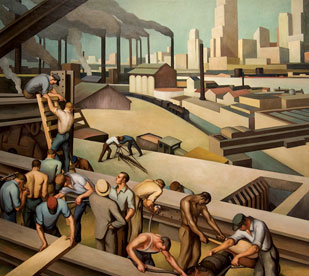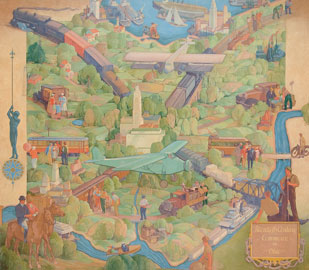Honoring American Labor in the Art of the Moyer Judicial Center

This mural is from the series The Progress of Industry, located in a first-floor hearing room at the Moyer Judicial Center. The mural showcases the early industrial landscape of Ohio, highlighting the dignity and hardship of physical labor.

This mural is from the series The Progress of Industry, located in a first-floor hearing room at the Moyer Judicial Center. The mural showcases the early industrial landscape of Ohio, highlighting the dignity and hardship of physical labor.
Labor Day is a time-honored tradition set aside for us to remember the contributions of the people who built this nation. History books tell us the first proposal of a national holiday honoring those who performed the back-breaking work in coal mines and steel mills came in the late 19th century, a time when the 12-hour workday was still the standard, and an era when children as young as five or six years old were forced to take jobs along dangerous assembly lines.
Those turbulent times are reflected in the original artwork of the state office building that would become the Thomas J. Moyer Ohio Judicial Center in the early 2000s.
Architect Harry Hake was instructed to design a building to honor the great people of Ohio. Hake designed the ground floor as a celebration of Ohio’s first settlers, Native mosaic ceiling consists of angular patterns that suggest a Native American theme.
The walls feature bas reliefs of Indigenous leaders who are part of Ohio history. These sculptures were completed by Paul Fjelde, the son of a Norwegian sculpture. Fjelde entered the Minneapolis School of Fine Arts at 14, before studying at the Art Institute of Chicago.
The first floor Grand Concourse, with its 30-foot ceiling, is lined with marble that reflects the European immigrants who formed the second wave of settlers west of the Ohio River.

Another of the 11 murals in The Progress of Industry series in the Moyer Judicial Center depicts scenes of a modern steel mill, the construction of a modern steel building, and a contemporary stone quarry, capturing the evolution of industry.

Another of the 11 murals in The Progress of Industry series in the Moyer Judicial Center depicts scenes of a modern steel mill, the construction of a modern steel building, and a contemporary stone quarry, capturing the evolution of industry.
Two conference rooms at either end of the Grand Concourse honor Ohio’s contributions to the national economy, and also give praise to the people who made it possible.
The hearing room at the north end of the building is dedicated to the people whose labor built Ohio and contributed to the economic growth of the nation. The murals are 13-feet tall and painted in muted greens and browns. A woman churning butter is featured alongside a wheelwright shaping a wheel that might be used on one of the farm wagons featured in the painting.
These vivid murals were the work of John Holmer, who attended the Art Academy of Cincinnati, before studying in Paris and Rome.
On the north wall of the hearing room, three panels depict the agrarian economy as it would have looked for much of the 1800s. People are carrying water, using hand saws to cut lumber, and oxen to pull a wagon of grain. Another ox pulls a plow as it cuts through a farm field. There is also a panel on the north wall depicting pottery production that was prevalent in eastern Ohio. A third panel features workers who are positioning the wooden floor joists for either a home or a barn.
The main panel on the south wall features a growing American city with skyscrapers in the background, and industrial smokestacks belching thick, black smoke. In the foreground is a collection of men busy working with steel I-beams. The scene could easily be a photograph of the steel mills in the flats of the Cuyahoga River valley just south of downtown Cleveland.

A second hearing room at the Moyer Judicial Center also displays 11 murals. This one illustrates the bustling commerce of 20th-century Ohio, reflecting the state’s economic development and growth during the 19th and 20th centuries..

A second hearing room at the Moyer Judicial Center also displays 11 murals. This one illustrates the bustling commerce of 20th-century Ohio, reflecting the state’s economic development and growth during the 19th and 20th centuries.
It seems appropriate that this hearing room was used in the 1930s by the Industrial Commission of Ohio.
The conference room at the south end of the Moyer Judicial Center is dedicated to commerce and transportation. The murals were painted by Herman H. Wessel, who was born in Indiana to Prussian immigrants. He was trained at the Art Academy of Cincinnati, and later spent three years in Munich and Paris studying painting.
The two murals that dominate the south hearing room are similar, each featuring an outline of the map of Ohio. One mural features the Ohio economy from the 1800s. The other depicts the trains, planes, boats, and automobiles of the 20th century.
At the time the artists were adding their finishing brush strokes to the building in praise of American labor, nobody could have predicted when workers would be back on the job. In 1933, the year the building was completed, more than 40% of factory workers in Ohio were without a job and 67% of construction workers sat idle.
When Chief Justice Thomas J. Moyer talked about this building while its renovation was underway, he was fond of quoting British wartime leader Winston Churchill, who once said “We make our buildings, and afterwards they make us.”
That is certainly true of the artwork made in the opening days of the Great Depression. The murals honoring factory workers and the farmhands of Ohio may have started as a salute to the people who built the state, but it is also possible that the murals served to inspire workers as they struggled to overcome the challenges of the Great Depression.


